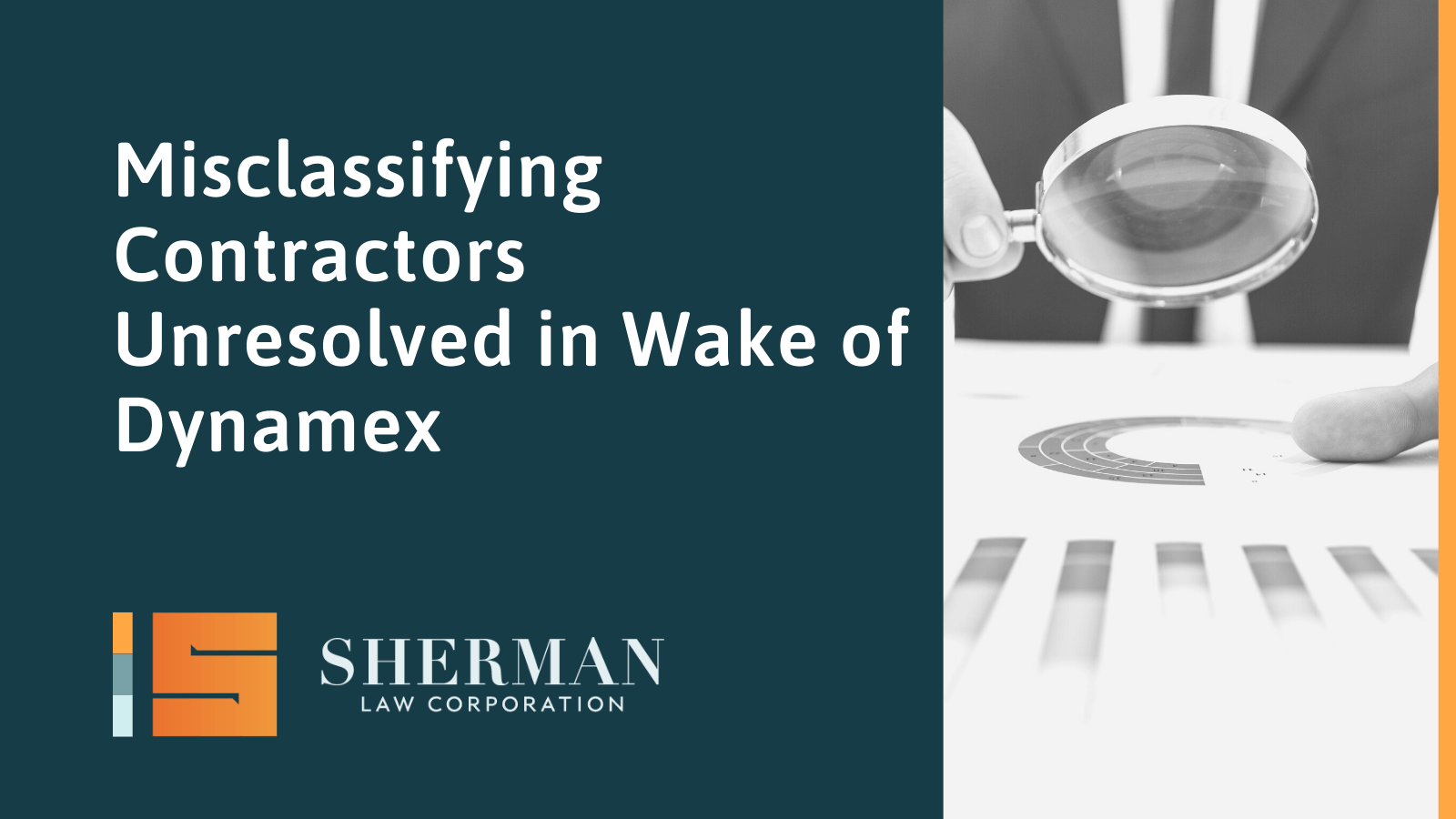
The California Supreme Court in the case entitled, Dynamex Operations West, Inc. v. The Superior Court of California, issued on April 30, 2018, changed how California employers classify their workers. In a case brought by drivers for Dynamex, a delivery service, the California Supreme Court issued an 82-page decision reinterpreting and ultimately rejecting the Borello test established in the 1989 case S.G. Borello & Sons v. Dept. of Industrial Relations, 48 Cal.3d 342 (1989), for determining whether workers should be classified as either employees or independent contractors for the purposes of the wage orders adopted by California’s Industrial Welfare Commission (“IWC”) in favor of a worker-friendly standard that has upended the existing independent contractor labor market that previously existed.
Specifically, the California Supreme Court embraced a standard presuming all workers are employees instead of contractors, and placed the burden on any entity classifying an individual as an independent contractor of establishing such classification is proper under the newly adopted “ABC test.”
Under the ABC test, a worker will be deemed to have “suffered or permitted to work,” and thus, an employee for wage order purposes, unless the putative employer proves:
(A) that the worker is free from the control and direction of the hiring entity in connection with the performance of the work, both under the contract for the performance of the work and in fact;
(B) that the worker performs work that is outside the usual course of the hiring entity’s business; and
(C) that the worker is customarily engaged in an independently established trade, occupation, or business of the same nature as the work performed.
Note that each of these requirements need to be met in order for the presumption that a worker is an employee to be rebutted, and for a court to recognize that a worker has been properly classified as an independent contractor. The strict test imposed by the Dynamex decision means that many workers who choose to be independent contractors may be forced to work as employees.
What this Means for California Businesses Post-Dynamex:
The question of whether an individual worker should be classified as an employee or independent contractor has considerable significance for workers, businesses, and the public. If a worker is classified as an employee, the employer bears the responsibility of paying Social Security and payroll taxes, unemployment insurance taxes and state employment taxes, providing worker’s compensation insurance, and of course, complying with the endless labyrinth of state and federal statutes governing the wages, hours, and working conditions of employees.
Indeed, many businesses, particularly those operating in the “gig economy,” are premised entirely on the use of independent contractors. In light of Dynamex, any businesses operating in California that treat workers as independent contractors should confer with their legal counsel to review the relationship under the “ABC test” and determine whether any or all such workers should be reclassified.
Prong B of the ABC test is particularly troublesome for any businesses that use independent contractors to deliver or provide their core product or service, such as hair salons. In applying the ABC test to Dynamex, the Court noted that a class of delivery drivers could be certified under prong B because the question of whether the delivery drivers were performing outside the usual course of Dynamex’s business could clearly be resolved on a class-wide basis. Indeed, delivery services—which are provided by the delivery drivers—are the very core of Dynamex’s business.
On October 22, 2018, in Garcia v. Border Transportation Group, LLC, (Case No. D072521, Fourth Appellate District, Division One), the California Court of Appeal followed the California Supreme Court’s guidance in Dynamex, and differentiated between a taxi driver’s Industrial Welfare Committee Wage Order claims, and non-Wage Order claims. In line with the Supreme Court’s decision, the Court of Appeal applied the ABC independent contractor test to Wage Order claims, while leaving other wage and hour claims for evaluation under the multi-factor Borello test. Even if a worker has unfettered freedom to establish and promote his or her own business, a purported independent contractor that fails to actually do so increases the hiring entity’s vulnerability to a misclassification finding. Part C is especially precarious because it scrutinizes the worker’s efforts, not the hiring entity.
As such, it is crucial for businesses to analyze whether the contractors they are working with have an established business and independently engage in work with other businesses. The Court of Appeal did not address Garcia’s non-Wage Order claims on their merits. This leaves California businesses, and workers, in the same post-Dynamex classification purgatory, where workers may be found to be employees under one test, but independent contractors under another.
Despite its apparent limited scope, the Dynamex case has created shock waves throughout California and those waves are now reaching the California Legislature. As part of the upcoming 2019 term, two separate bills have been introduced. The first, Assembly Bill (AB) 5, introduced by Lorena Fletcher, a Democrat from San Diego, seeks to codify the ABC Test into the Labor Code, thereby having wide implications for areas beyond wage orders. The second, AB 71, introduced by Melissa Melendez, a Republican out of Lake Elsinore, seeks to do just the opposite and codify the factors established by the Borello case and essentially nullify the decision set forth by the California Supreme Court in Dynamex.
Dynamex retroactivity, although currently undecided by the 9th circuit in Lawson v. Grubhub, will likely be determined by higher courts to be retroactive. Recent lower court holdings such as Oriana Johnson v. Imperial Showgirls (Orange County), issued on October 22, 2018, show a leaning to apply Dynamex retroactively. In that case, the judge held that Dynamex, which had been going on for 13 years by the time the Supreme Court issued its landmark decision, was intended to apply retroactively because “it did not state that its decision applied only prospectively.” “Given the age of the claims in the Dynamex case, and given the court’s longstanding acknowledgment of its authority to make such a statement … the lack of such a pronouncement suggests that the decision should apply retroactively,” Judge Claster wrote. “Although not necessarily determinative, the court’s later decision to deny requests to modify its decision to state that Dynamex will only be applied prospectively supports this conclusion.”




